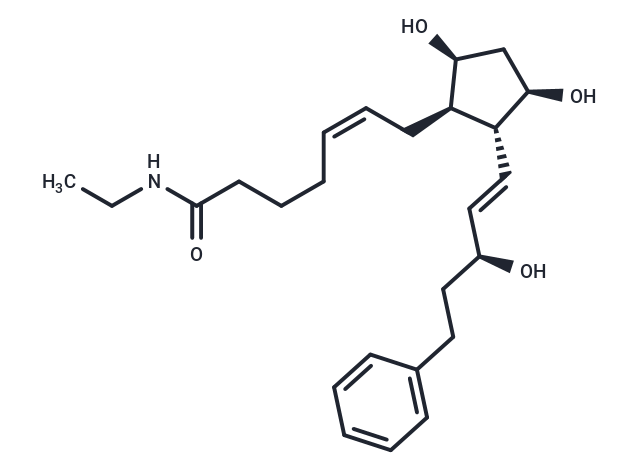Shopping Cart
- Remove All
 Your shopping cart is currently empty
Your shopping cart is currently empty

Bimatoprost (AGN 192024) is a cloprostenol-derived amide that is used as an antihypertensive agent in the treatment of open-angle glaucoma and ocular hypertension.

| Pack Size | Price | Availability | Quantity |
|---|---|---|---|
| 2 mg | $30 | In Stock | |
| 5 mg | $48 | In Stock | |
| 10 mg | $81 | In Stock | |
| 25 mg | $150 | In Stock | |
| 50 mg | $271 | In Stock | |
| 100 mg | $458 | In Stock | |
| 1 mL x 10 mM (in DMSO) | $53 | In Stock |
| Description | Bimatoprost (AGN 192024) is a cloprostenol-derived amide that is used as an antihypertensive agent in the treatment of open-angle glaucoma and ocular hypertension. |
| In vitro | Bimatoprost is an effective prostaglandin FP receptor agonist, capable of directly inducing a robust and rapid return of calcium ions to baseline levels. It directly activates FP prostaglandin receptors in rats, mice, and humans. |
| In vivo | Bimatoprost displaces [3H] prostaglandin F (2alpha) binding to FP receptors with a Ki of 6.31 μM. It rapidly mobilizes intracellular calcium in 3T3 mouse fibroblasts expressing FP receptors (EC50: 2.2 μM) and human embryonic kidney cells with human FP receptors (EC50: 2.94 μM). Bimatoprost upregulates Cyr61 expression in feline irises and mildly stimulates aqueous humor outflow rate, increasing it by 13% during the day and 14% at night, while reducing tonographic outflow by 26%, thereby lowering intraocular pressure. |
| Alias | AGN 192024 |
| Molecular Weight | 415.57 |
| Formula | C25H37NO4 |
| Cas No. | 155206-00-1 |
| Smiles | CCNC(=O)CCC\C=C/C[C@H]1[C@@H](O)C[C@@H](O)[C@@H]1\C=C\[C@@H](O)CCc1ccccc1 |
| Relative Density. | 1.145 g/cm3 |
| Storage | store at low temperature,keep away from moisture | Powder: -20°C for 3 years | In solvent: -80°C for 1 year | Shipping with blue ice. | ||||||||||||||||||||||||||||||||||||||||
| Solubility Information | DMSO: 34 mg/mL (81.82 mM), Sonication is recommended. Ethanol: 77 mg/mL (185.29 mM), Sonication is recommended. H2O: < 1 mg/mL (insoluble or slightly soluble) | ||||||||||||||||||||||||||||||||||||||||
Solution Preparation Table | |||||||||||||||||||||||||||||||||||||||||
DMSO/Ethanol
Ethanol
| |||||||||||||||||||||||||||||||||||||||||

Copyright © 2015-2025 TargetMol Chemicals Inc. All Rights Reserved.